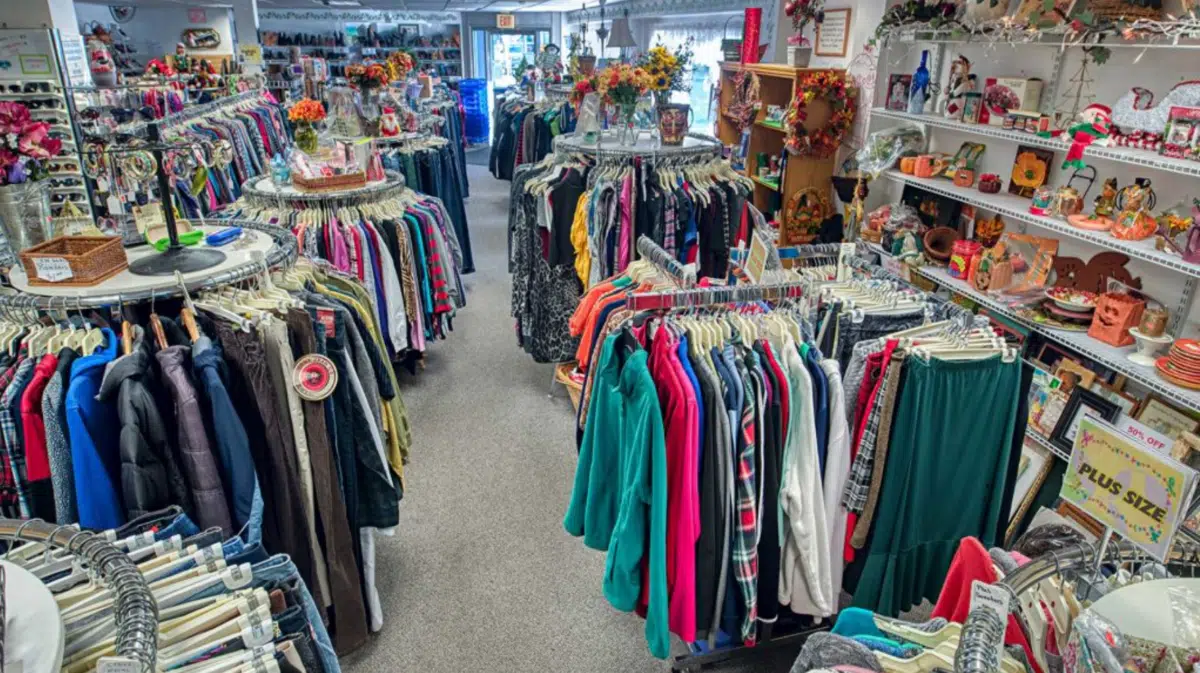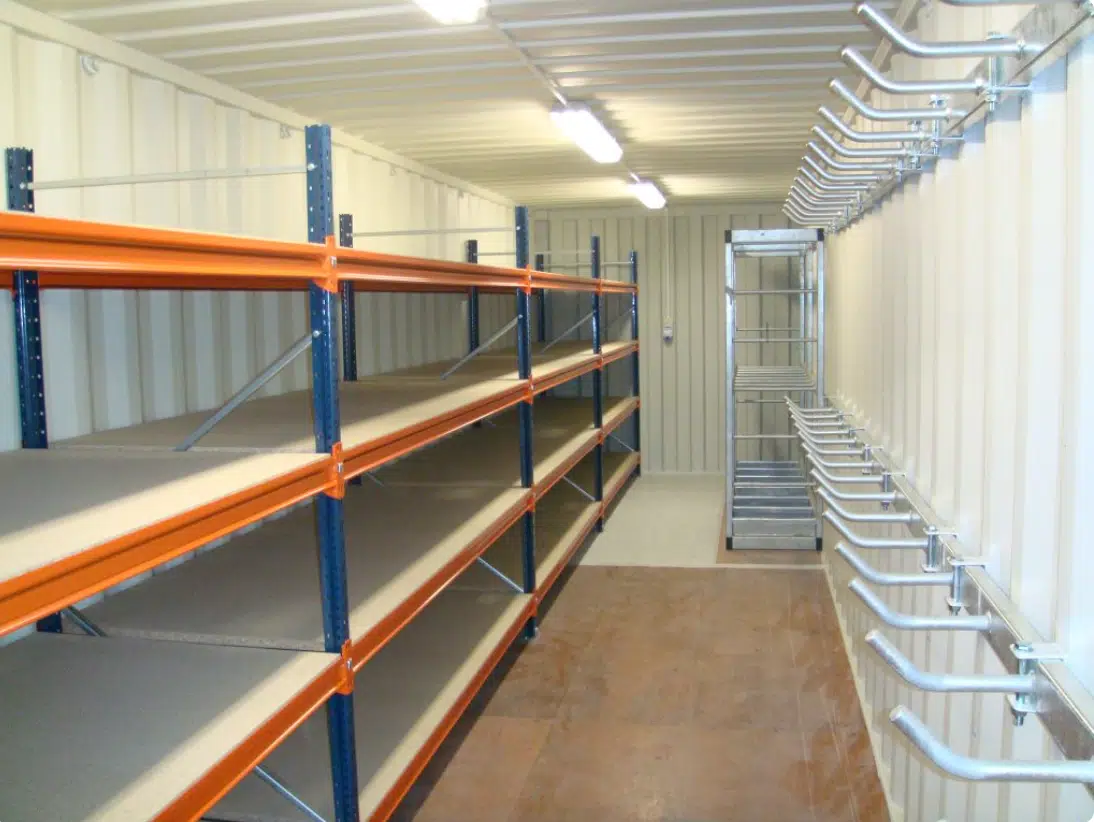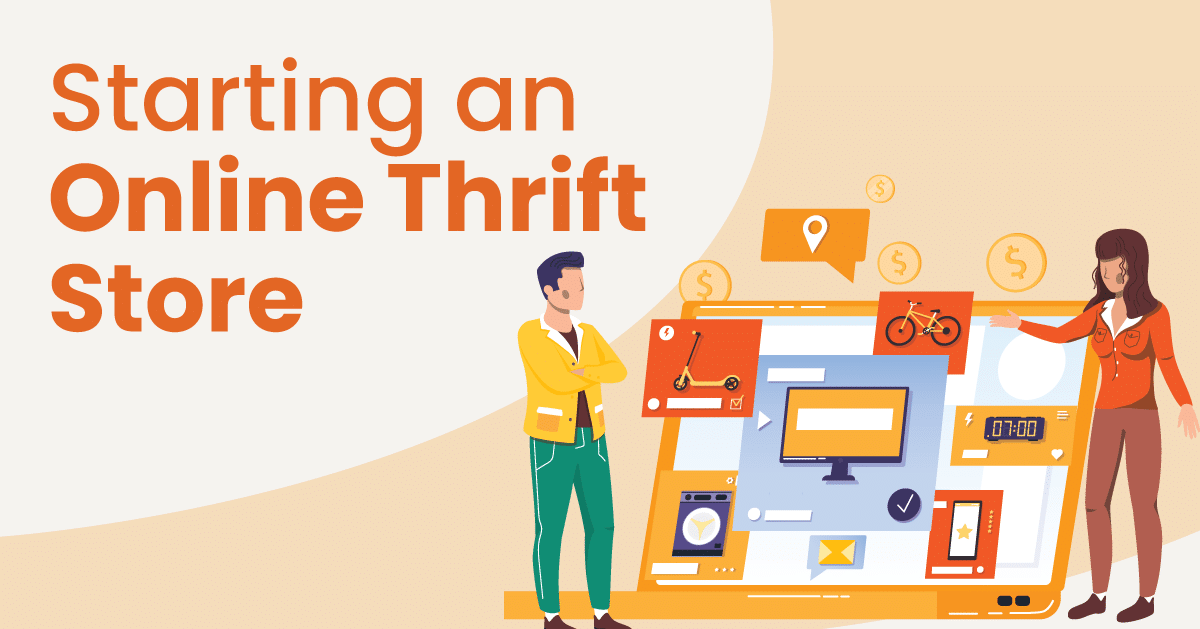
To start an online thrift store, first conduct market research and then find your niche. Once you have determined your niche, create your brand and then launch your online thrift store. You can launch the store as an eCommerce platform, a self-hosted platform, or sell on marketplaces. Once your online selling platform is established, search for products and manage your inventory. The last steps in creating your online thrift store are finding a place to store your products and investing in a thrift store point of sale system for better inventory tracking and easy payments.
If you’re looking for a lucrative business idea, starting an online thrift store may be a good one. Selling older stuff has never been more popular, or easier. And doing so online has made it more accessible for both the retailer and the consumer.
The pre-owned market is expected to reach $77 billion by 2025 compared to $36 billion in 2021 and is growing at 11 times the rate of the general retail apparel sector. Scores of Generation Z consumers are setting up online stores to sell their used and vintage products. And they’re advertising wisely on Instagram and TikTok, further boosting the thrifting craze. Plus, the movement to waste less and reuse more has led more consumers than ever to buy used and avoid the fast fashion of H&M, Forever21, and many other major apparel retailers.
Resale platforms like Depop, thredUP, and Poshmark have also turned young buyers into stylists who can earn some money. However, some of the more notable successes overshadow the work that goes into creating a long-lasting business.
Starting an online thrift store business can seem tedious and nerve-wracking, but it can also be gratifying if you dedicate yourself to it. Read on to learn more about the different steps to start an online thrift store business.
Steps To Starting a Successful Online Thrift Store
1. Conduct market research and find your niche
The first step in opening an online thrift store is to undertake market research. This research aims to understand consumers’ desires and then verify that your business model is viable for a particular market.
It will also allow you to evaluate the current state of that market and confirm that it’s not already overwhelmed by similar concepts. Additionally, you will need to analyze existing online thrift stores in the United States and international markets to find what is trending, what works, and what consumers like.
In addition to statistics and industry trends, conducting market research for your thrift store will help you learn more about your target market, including who your customers are, what types of items they like, how often they buy new items, and how much they typically spend.
The information gathered at this point will also be of significant value in developing your financial projections and determining the concept for your thrift store. The following is an overview of the information you will need to gather from the marketplace:
- What is the current state of the thrift store industry? Is it growing or faltering?
- How has the turnover of thrift stores evolved over the last few years?
- How many online thrift stores opened/shut down last year? Why did they fail?
Besides the market data, you will also need to learn a little more about your customers. Here are some questions you may ask yourself:
- When do consumers shop at online thrift stores, and for what purpose?
- How much are they willing to spend on used clothing?
- What is the age of a typical online thrift store customer?
- What is their average income and budget?
- How can you reach the right consumers?
- Which platforms are most visited by these consumers?
Check out some popular online thrift stores, read reviews, talk to typical consumers, and learn more about what customers like and don’t like.
You want your online thrift store to offer a unique experience. To do this, you need to provide a well-curated selection of items. Choose a niche that interests you and that you know something about. Here are some common types of merchandise that thrift store owners sell:
- Clothing
- Books
- Furniture
- Appliances
- Sporting goods
- Art
- Shoes
2. Create your brand
Once you’ve found the right niche for your business, it’s time to think about your brand. Branding is a story you want to tell about your business. As a general rule, your name, logo, design, and style should align with the brand’s core message. Choosing a name for your brand is very important. Be sure to choose a short, memorable, and unique name.
However, choosing a name has to comply with the rules in your state or county. You can contact your state’s business registration agency to see if businesses with the same name exist in your state. You can also visit the USPTO website for more information on how to trademark your business name to avoid legal troubles down the stretch.
3. Set up your online thrift store
Determine how you want to sell your products before you start buying them. When it comes to starting your online thrift store, there are three different routes you can go:
An eCommerce store
eCommerce platforms are the most straightforward way for new sellers to sell online. Most eCommerce platforms give sellers the ability to select and customize templates without the need for technical skills.
eCommerce platforms are much more convenient for most sellers, especially smaller operations; custom websites are extremely costly to build and difficult to maintain. In addition, most eCommerce platforms offer a dedicated support team available to help you set up your store. Some of the best eCommerce site builders include Shopify, GoDaddy, WooCommerce, Zyro, Volusion, Wix, and Magento.
Self-hosted platform
You can also choose to create your own website for online thrift selling on platforms like WordPress. The advantage of this direction is that you have full ownership and control of your website. However, you will have to pay for a domain name, web hosting, and security measures.
As we mentioned above, this option is much more advisable if you have more time, money, and technical confidence. Of course, the customization possibilities are endless if you know how to code, but this is not a solution we recommend to beginners. In addition, the implementation process will be much longer.
Sell through marketplaces
Selling on marketplaces such as Amazon, or alternatives like eBay, is a great way to get seen by more consumers. Doing so is also quite convenient. Millions of people around the world visit these online stores every day to buy products. It’s nearly impossible for small retailers and new businesses to reach such a large audience.
Online marketplaces, instead, offer thrift retailers a platform to build a much larger customer base. In addition, these marketplaces face very few technical problems and are thus more reliable. With that said, the competition is fierce, and fees can add up and significantly eat into your margins.
Those looking to sell without necessarily buying can turn to Flyp, a simplified and hassle-free service to sell your old clothes. For vintage clothing online, Retro and Me is the go-to place for clothing from the 50s to 90s. Plus, they donate 10% of sales to charitable initiatives, an approach that makes the brand more appreciated by most consumers. Other popular online retailers include Tradesy, Refashioner, Urban Renewal, Goodwill, The Real Real, Beyond Retro, Patagonia Worn Wear, and Luxury Garage Sale.
Leveraging online marketplaces is fine, but it’s not a great long-term solution. Typically, it’s best to sell on both these marketplaces as well as your proprietary website. Just be sure to encourage consumers to visit your website.
4. Source products and manage your inventory
Sourcing products in a thrift store business is different from other types of retail. Every item in a thrift store is unique and it’s rarely possible to buy your inventory in bulk.
Start with a small collection. Keep it niche and avoid making large investments into items that you’re not sure will sell well. Visit garage sales, thrift stores, other online thrift hotspots like eBay, clearance stores, consignment stores, and flea markets. Donations from community events, estate sales, yard sales, and moving sales are all ways to source your products. Just keep in mind that the cheaper your collection is, the more time you will have to spend making it.
Tip! For even better loot, try going to thrift stores located either further out of town (where good items are less likely to be bought immediately) or in affluent neighborhoods (where the quality of the stock is probably better).
Once you have your products, inventory management becomes crucial to monitor. Usually, the most common way to manage a thrift store inventory is through inventory management software that keeps track of items from each of your sales channels. If you have a brick-and-mortar store, find the right thrift store POS to integrate with your eCommerce channels.
5. Find a place to store your products
Now that you have your inventory ready to sell, the next question is where to store it. If you’re just getting started, you might be able to use extra space at home. This will quickly get out of hand, however. It’s important to consider a more permanent place from the beginning so that you can transition effectively as your business grows.
For most online retailers, this means renting a storage unit. Stockroom management is just as important as creating a system for storing and tracking your inventory. It’s also recommended that you store your inventory to match how it’s categorized on the website.

6. How To Price the Products of Your Thrift Store?
Setting the right prices for your resale business is a balancing act. You don’t want to price an item too high and discourage potential buyers, but you also don’t want to price it too low to make a profit. Before pricing your products, you need to consider two fundamental aspects: manage your margins and check out the competition.
Managing your margins includes the raw costs of your products as well as expenses related to packaging, shipping, transaction/sales costs, and all fixed business costs (storage rent, website hosting, IT work, employees, insurance, etc.
Competition is also a key aspect to consider when pricing your products. You’re selling in a competitive industry, so you’ll need to price your products competitively. If you’re selling something a little more unique or custom, you have a little more leeway, but it’s always worth checking the online price of similar items.
But if you’re in the vintage market be careful not to inadvertently sell an item for less than it’s worth because you didn’t check properly. Be sure to check the prices of your competitors and the value of the products you are selling.
7. How To Market Your Online Thrift Store Business
In order to thrive in this industry, you will have to make your thrift store stand out. Thus, starting an online thrift store means being ready to learn some digital marketing basics. Once you’ve built your website, you need to ensure that it can attract traffic and then turn those visitors into customers. With this in mind, marketing is not an element to be neglected. There are several elements to consider in a solid marketing plan:
SEO (Search Engine Optimization)
Maybe you’ve heard of SEO but didn’t know exactly what it means and how to go about it. Simply put, it’s the process of improving your site to increase its visibility when people search for products or services related to your business. Typically, such searches occur in Google, Bing, and other search engines.
The more visible your pages are in search results, the more likely it is that you’ll attract attention and bring potential and existing customers to your business. So it’s essential to give your business the highest chance of appearing on the first page of Google’s search results for terms related to your products by helping Google understand your site’s content and establishing your website as an authoritative source of information.
If you want to learn more, blogs like Semrush, Neilpatel, Ahrefs will help you learn more about SEO. You can also outsource your site’s content management to relevant digital marketing agencies if you have the resources.
Social media marketing
Social networks are a treasure trove for many businesses, especially thrift retailers. Instagram and TikTok are probably the most powerful platforms available to any new eCommerce business, especially one that sells to a younger audience.
Global internet users between the ages of 16 and 24 prefer Instagram over other social platforms. 47% of TikTok’s users are between the ages of 10-29, and 42% of its users are between 30-49. This means that TikTok is a cross-generational app that allows brands to reach audiences of all age groups.
Instagram will allow you to expand by posting photos of your products and creating a buzz around your brand through influencers. With TikTok, you can create trendy videos with the chance of going viral.
8. Sort Out All Legal Documents
It is worth noting that there are some basic legal documents needed to run an online thrift store. These documents play a vital role in protecting the interests of the business and its owners throughout the business’s life.
Like any business, it’s important to make sure you have the basics down:
- Social security number
- Tax identification number
- Employer’s identification number
- Insurance
- Online privacy policy
- Online terms of use
- Wholesale license
- Seller’s permits
- Business Structure Registration (LLC vs sole proprietorship)
Use the Right Thrift Store POS System To Run Your Online Store
As your online thrift store grows, you must be able to keep track of your inventory, facilitate customer transactions via your website, manage promotions, process payments, and more. KORONA POS offers a robust thrift store POS system designed for retail businesses both online and in physical stores.
The software integrates with a robust and fully customized WooCommerce integration for eCommerce operations, allowing you to smoothly list products, run promotions, and execute marketing campaigns.
The software also provides you with a CRM database with your loyalty program, allowing you to contact lapsed customers easily and get people back in your store more often. Click below for a product demo once your business is launched.
FAQs: How To Start An Online Thrift Store
You can start a thrift store business either online or by going the brick-and-mortar route. Either way, first understand how the thrift store industry works by doing market research and determining your niche. Then, look to source your products from certain vendors or platforms like Amazon, Etsy, Craigslist, or consignment stores. Find a good location for your business if you have decided to go down the physical store route. However, if your business is online, you’ll need to leverage SEO and other digital marketing strategies to get your business noticed.
If you have a knack for thrift shopping and know what items are worth reselling, you may have a deal on your hands. Thrift shopping for profit is easy, fun, and can be very cost-effective. According to estimates, the average 10-person thrift store may only generate $11,880 in annual profits.
To launch a thrift store on Instagram, figure out what people want to buy. Stay on top of the seasons and trends that come and go. Come up with specific styles that meet their needs. Keep an eye on trends to ensure your items will appeal to potential customers. Post constantly and partner with influencers to spread the word about your brand.












